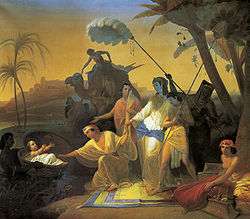Ark of bulrushes
Appearance

The ark of bulrushes daubed with asphalt and pitch, in which the infant Moses was laid (Ex. 2:3), is called in the Hebrew תֵּבָה (tebah, modern teiva), a word similar to the Egyptian teb, meaning "a chest". It is also the same word used for Noah's Ark. The bulrushes (Hebrew: גֹּ֫מֶא gome) were likely to have been papyrus stalks (Cyperus papyrus), daubed with bitumen and pitch (which probably refers to the sticky mud of the Nile).[1]
The ark containing the three-month-old baby, Moses, was placed in reeds by the river bank (presumably the Nile) to protect him from the Egyptian mandate to drown every male Hebrew child,[2] and discovered there by Pharaoh's daughter.
A similar story is told of Sargon of Akkad.[3]
See also
References
- ^ "Bible search". NET bible studies.
- ^ Exod. 1:22
- ^ . New International Encyclopedia. 1905.
